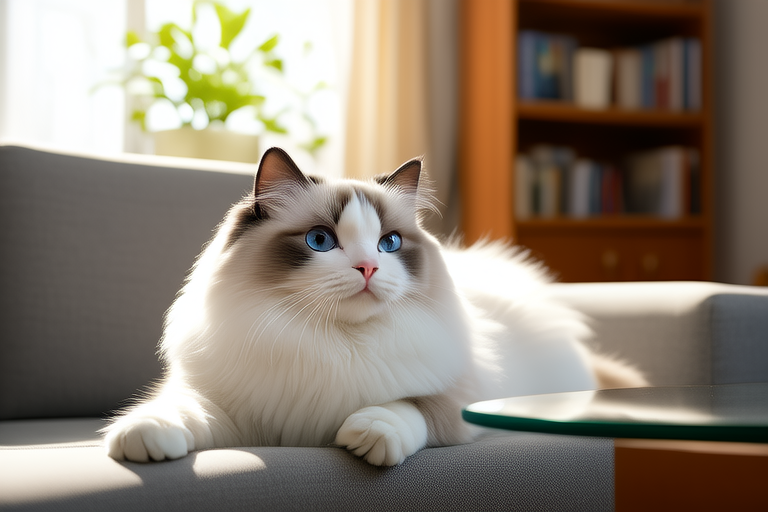From Playful Pussycats to Gentle Giants: Inside the Life of a Ragdoll
The world of feline companionship is vast and varied, offering an array of breeds to suit every lifestyle and personality. Among these, the Ragdoll stands out as a unique and beloved choice. Known for their docile nature and affectionate demeanor, Ragdolls have captured the hearts of many cat lovers. In this article, we will explore the fascinating world of Ragdolls, delving into their unique characteristics, rich history, and the care they require to thrive.
Unique Characteristics of Ragdoll Cats
Ragdolls are renowned for their docile and gentle nature, making them perfect companions for those seeking a serene and loving pet. Their affectionate demeanor sets them apart from many other cat breeds, as they are known to follow their owners around the house, seek out human interaction, and enjoy being carried like babies. This breed’s calm and relaxed disposition makes them excellent candidates for families with children or homes where a tranquil atmosphere is desired.
Physically, Ragdolls are medium to large-sized cats with a semi-longhair coat that requires regular grooming. Their coats come in various colors and patterns, adding to their charm and allure. One of the most striking features of Ragdolls is their deep blue eyes, which add to their regal appearance. These eyes, combined with their plush fur, create a look that is both elegant and inviting.
The History and Origins of Ragdolls
The story of the Ragdoll begins in the 1960s in California, where a breeder named Ann Baker developed the breed by crossing Persian and Birman cats. The breed’s name comes from its tendency to go limp when picked up, resembling a rag doll. This trait, along with their affectionate nature, has made Ragdolls a popular choice among cat enthusiasts.
The development of the Ragdoll breed was a labor of love for Ann Baker, who sought to create a cat that would be gentle, loving, and easy to handle. Over time, her efforts paid off, and the Ragdoll became recognized by major cat registries worldwide. Today, Ragdolls are cherished for their unique qualities and continue to be one of the most popular cat breeds.
Ideal Living Conditions and Care Requirements
To ensure your Ragdoll thrives, it is essential to provide them with an environment that meets their needs. Ragdolls prefer a quiet, stable home where they can relax and feel secure. They enjoy comfortable, cozy spaces where they can curl up and take naps, so providing soft bedding and designated resting areas is crucial.
Nutrition plays a significant role in maintaining a Ragdoll’s health and well-being. A balanced diet rich in proteins, vitamins, and minerals is necessary for their growth and vitality. Consult with a veterinarian to determine the best food options for your Ragdoll based on their age, weight, and activity level.
Grooming is another important aspect of caring for a Ragdoll. Their semi-longhair coat requires regular brushing to prevent matting and tangles. Additionally, regular nail trimming, ear cleaning, and dental hygiene are essential to keep your cat healthy and happy.
Health concerns specific to Ragdolls include hip dysplasia and hypertrophic cardiomyopathy. Regular veterinary check-ups and screenings can help catch any issues early and ensure your Ragdoll lives a long and healthy life.
Behavior and Temperament: Gentle Giants at Heart
Ragdolls are often referred to as “gentle giants” due to their large size and calm demeanor. Despite their relaxed nature, Ragdolls can still exhibit playful tendencies, especially during their younger years. Many owners report that their Ragdolls enjoy interactive toys and games, such as fetch or chasing laser pointers.
One story that illustrates the playful yet relaxed nature of Ragdolls involves a family who adopted a Ragdoll kitten. The kitten, named Luna, quickly became a favorite among the household members. Luna loved to play with toys but always returned to her owner for cuddles and attention. Her ability to balance playfulness with relaxation made her a beloved addition to the family.
Advice for Potential Owners
When considering adopting a Ragdoll, it is important to understand the commitment involved. Ragdolls require regular care, attention, and a stable environment to thrive. They are highly social animals and do best in households where they will receive plenty of love and companionship.
Ragdolls are generally compatible with families and other pets, provided they are introduced gradually and given time to adjust. Their gentle nature makes them ideal for households with children, as long as the children are taught to handle the cats gently and respectfully.
In conclusion, Ragdolls are a unique and charming breed with a lot to offer. Their docile nature, affectionate demeanor, and striking appearance make them a popular choice among cat lovers. By understanding their needs and providing proper care, you can ensure that your Ragdoll lives a happy and fulfilling life. Consider adopting a Ragdoll and experience the joy of having a gentle giant by your side.
